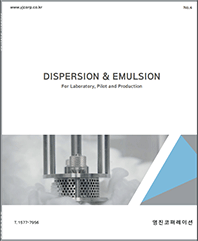| Phone |
| |
| |
| 대표전화 |
1577-7956 |
| 본 사 |
031-457-9187 |
| 대 전 |
042-932-1265 |
| |
|
| Web Site Visitors |
| |
| |
| Today |
547 |
| Yesterday |
1304 |
| Since 2006 |
2,340,651 |
| |
|
 |
|
| 영진코퍼레이션 종합카다로그 |
|
|
|
2000년 첫 개최된 이후 3년마다 아시아 각 국가에서 순회 개최되고 있는 APT (Asian Particle Technology) Symposium 은
아시아 각 국가의 particle 관련 연구인들이 모여
particle preparation and design, indusrial and engineering applications, analysis of particle behavoir and performances,
modeling and simulations, particle-fluid systems, powder metallurgy, mineral processing, particles for nanotechnology,
biological and pharmaceutical particles, cements, paints and pigments, fertilizers 등의 분야에 대한 새로운 기술과 연구결과를
발표하는 심포지움입니다. |
|
|
2000 : Thailand
2003 : Malaysia
2006 : China
2009 : India
2012 : Singapore
2015 : Seoul |
 일 시 : 일 시 : |
15 - 18 Sep. , 2015 |
 장 소 : 장 소 : |
COEX, Seoul |
 Site : Site : |
www.apt2015.org |
 주 최 : 주 최 : |
한국화학공학회 미립자공학 부문위원회 |
 후 원 : 후 원 : |
서울시 |
 APT 2015 안내문 다운로드 APT 2015 안내문 다운로드 |
 |
| |
 Subject 1 : Subject 1 : |
New insight into concentrated micro- and nanodispersions by X-ray concentration profiling |
 Session : Session : |
[OP05] Other topics related with particle technology-1 |
 Time : Time : |
11:50 - 12:05 (Wed) Sep. 16, 2015 |
 Location : Location : |
Conference Room (South) 307B |
 Abstract : Abstract : |
Characterization of dispersions, e.g. regarding separation phenomena (stability) and homogeneity
is problematic for concentrated nontransparent dispersions but also transparent nanodispersions.
This applies even more in case of complex mixtures, when the dispersed phase is a mixture of two
or more materials. In particular it is difficult to define a separation level and to quantify differences
in solids concentration inside the sample. To overcome these difficulties a new analytical
instrument - the LUMiReader X-Ray - has been developed. The working principle is based on
measurement of space and time resolved X-ray transmission profiles over the entire sample height.
In contrast to optical measurements X-ray transmits very highly concentrated dispersions, powders
and composite materials. Recorded X-ray intensities depend only on mass concentration of particles
and do not depend on particle size and shape. The new approach can be easily applied to detect
inhomogeneities e.g. in mortars and creams or after dispersing particles in liquids or polymers.
On the other hand kinetics of separation phenomena at earth gravity as well as in combination
with analytical centrifugation can be analyzed and local sediment packing studied (see figure left .
concentration profiles inside flocculated lime sediments as function of relative centrifugal force
applied). Segregation results for dispersions made of mixtures of different materials (different
X-ray absorption properties), like dispersions in paper industry and colour cosmetics, will be also
presented (see figure right - dark blue nail varnish sample after 2 hours centrifugation at RCF 2300.
photo and extinction profile . pigment segregation detectable by X-ray). 초록 다운로드 |
| |
 Subject 2 : Subject 2 : |
Characterization of dispersibility and dispersion quality |
 Session : Session : |
[OP15] Process analytical technologies, particle characterization and monitoring-1 |
 Time : Time : |
17:15 - 17:30 (Wed) Sep. 16, 2015 |
 Location : Location : |
Conference Room (South) 307B |
 Abstract : Abstract : |
To make an economic use of raw materials in suspension based formulations one has to obtain
a high degree of dispersion. This is related also to practical aspects like achieving high hiding
power at lower pigment concentration and of outstanding material properties in composites.
Dispersibility and the resulting quality of dispersion are determined by several factors including
structure/quality of the raw materials and dispersion media, dispersion process and additives,
which have to be characterized and quantified. Regarding selection of dispersion media and
additives determination of Hansen solubility parameters (HSP’s) can be used as a guide to reduce
trial and error. A multisample analytical centrifugation technique with photometric detection
(LUMiSizer, LUM, Germany) is used in this study for instrumented evaluation of dispersibility and
dispersion quality as well as for determination of HSP for pigments. Multisample analytical
centrifugation approach enables the direct determination of dispersion stability at original
concentration. Even more information about dispersion structure (e.g. flocculation state) is
obtained. A dispersibility index is proposed for characterization of the materials to be dispersed.
A broad range of examples is given ranging from pigment dispersions (see example below for
different batches of a pigment paste), over pharmaceutical applications to high tech material like
graphene and carbon nanotubes. Determination of the HSP for pigments is exemplified using
the multisample capability of the instrument. 초록 다운로드 |
| |
|
 |
| 활동내역 |
|
- |
1994년, Suspension과 Emulsion 분야의 발전을 위해 혁신적인 장비를 개발하겠다는 목표로 LUM GmbH 설립 |
| - |
Dispersion Analysis, Colloid Chemistry, Blood Rheology and Fluid Dynamics 분야 저널에 250편 이상의 논문, article 발표 |
| - |
ISO 회원이며, Particle Characterization 의 working group 2 (sedimentation methods) 와
working group 16 (stability)의 의장 |
| - |
국제학술지 Biorheology (IOS 출판)의 편집위원회 회원 |
| - |
Particle Measurement Technology, Fluid Separation and Rheology 의 German national VCI committees 회원 |
|
| 학 력 |
| - |
現 독일 베를린 Humboldt University 의학물리 및 생물물리학 전임교수 |
| - |
前 독일 베를린 Humboldt University 의과대학 의학물리 및 생물물리학과장 |
| - |
독일 베를린 Humboldt University 생물물리학 박사 취득 |
| - |
러시아 모스크바 Lomonossow University 졸업 |
|
| 수상내역 |
| - |
Biophysical Society of Shanghai (중국) 명예회원상 |
| - |
Int. Society of Filtration (영국) 금메달 |
| - |
2012 of Berlin_Brandenburg (독일) 혁신상 |
|







